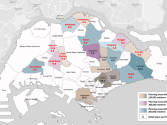What you need to know about Vietnam's bank restructuring
By Mohit Mehrotra & Anurodh PandeyThis article illustrates key drivers behind restructuring of banks in Vietnam and highlights the key priorities in the restructuring journey.
“In light of broader macro-economic environment it is a strategic imperative for Vietnamese banks to restructure and reposition themselves to maintain and improve their presence in the marketplace.”
The financial institutions landscape in Vietnam is undergoing a major restructuring phase. The move by the central bank to overhaul the banking system, bring down the total number of banks to a reasonable level, control hyper credit growth, standardize accounting policies and improve capital management has forced banks to rethink their business models. More often than not restructuring is a result of competitive response; in the case of Vietnam it is a combination of multiple factors including, a fundamental shift in the nature of industry, market demand (ie growing needs of retail), Small and Medium Enterprises (SME) and corporate clients.
The total commercial bank loans to GDP ratio for Vietnam, is amongst the highest in the region (over 120%). This ratio is reflective of relative saturation of the banking sector compared to other markets. From 2008 to 2010, the economy (GDP) grew between 6%-7% whereas, commercial bank loans grew at a rate of nearly 30%. Inflation is highest in Vietnam among ASEAN nations, and averaged approximately 16% for the period 2008-2011. During the same period joint stock commercial banks doubled their asset base creating intense competition in the banking sector. Out of the top 20 banks in Vietnam, more than 10 managed to maintain an average asset growth of over 40% while maintaining an average Return On Equity (ROE) of over 20%.
Hyper credit growth over the last few years has resulted in buildup of poor quality of assets. Although official NPL (Non- Performing Loans) statistics remain at 3.5% as of mid-2011, the accuracy of such numbers is questioned. With overall weak repayment ability, the corporate sector is facing downward pressure and this will further fuel banks’ NPL. Large commercial banks have significant exposure to state owned enterprises (estimated at over 27%) while small and mid-sized banks carry significant real estate exposure. Some banks faced acute liquidity issues, with overnight interest rates going as high as 20% in 2011. While large banks have the appetite to deal with a rising NPL ratio; small banks with small capital base face a tough situation. Increasing NPL ratio will impact on the profitability of banks which is largely derived from interest income (70 - 90% of total income) and low fee based income.
Although current measures taken by the State Bank of Vietnam have helped in curtailing hyper credit growth, such measures may have to be extended further to control credit quality. So far in 2012, Vietnamese banks experienced negative loan growth driven by the government’s push to curb loan growth in order to control inflation. As a result, inflation fell below 10% for the first time since October 2010. The agriculture sector and overall exports recorded significant growth of 24% for the first half of the year and as such, banks are now being urged to increase issuance of fresh loans to such export oriented sectors.
Overall a high degree of uncertainty exists in the banking sector. With changes to loan classification standards, it is likely that the NPL ratios of Vietnamese banks will increase, which will in turn, have implications on financial ratios of banks (ROA, ROE etc.). Increase in capital requirements will require banks to effectively and efficiently manage their capital. As more mergers are expected, they will create a unique set of challenges arising from integration of products, services, operations and human capital.
Restructuring priorities
The restructuring objective for banks has multiple complex dimensions. Quick fix measures should focus on reducing NPL ratios, disposing non-core assets and improving capital position. The longer term objectives should focus on meeting broader objectives of key stakeholders of the bank including, shareholders (returns, value maximization), customers (ability to meet changing client needs), regulators (prudent financial operations), employees (workplace rewards) and the broader society (socially responsible banking).
Changes to the core business model can lead to changes in, core markets in which the company operates, segment focus of the company, broader products and services and restructure funding and capital management of the bank. Vietnamese banks should relook their current business models and explore various growth options from building physical presence in ASEAN, to exploring revenue sharing alliance models as a key driver of new business growth. The base operating model should focus on rejuvenating the underlying organizational functional delivery and/or the business process landscape. The focus of restructuring programs can vary from moving away from current processes, to an efficient and managed systematic structure across varied functions such as sales, service delivery, finance, accounting, risk and human resources, etc.
Objectives of restructuring vary across institutions and there is no set defined formula that can be used to create a winning play. It is important to identify the right level and pace of restructuring by balancing trade-offs and choices of different value creation strategies. The pace at which a firm is able to restructure is dependent on its current capabilities, organizational structure and executive support and executive alignment is essential to a successful restructuring journey.
Understanding the alignment of the core capabilities of the institution to restructure activities is critical for generating value. Experience in numerous restructuring events suggests that behavior-led strategy execution, change management capabilities are imperative for successful restructuring, and that a clear governance and decision making model are required, for execution. Institutions should not underestimate the challenges in sourcing different skill sets that are required for the restructured business and operating model. Many tend to ignore the impact of the revised performance metrics that are critical to sustain restructured activities.
Conclusion
Restructuring across the institution is a critical activity that needs sophisticated planning and execution skills. There are significant domestic and regional opportunities available for Vietnamese banks to build a more diversified play. It would be essential for Vietnamese banks to create the fine act of balancing compliance risk and rewards, diversifying funding sources, deepening customer driven product value propositions and transforming themselves to compete both at local and regional level.























 Advertise
Advertise










